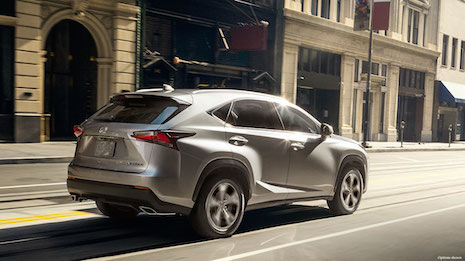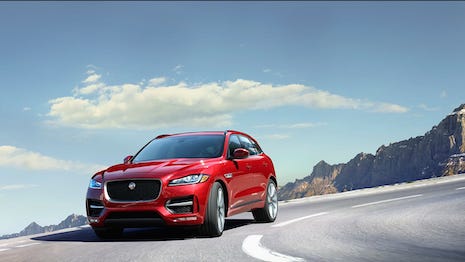A combination of more affordable models and an increased focus on sport utility vehicles has helped luxury brands grow their market share in the broader automotive sector this year, according to a new report from Edmunds.
Changes such as new products and brands entering the luxury field for the first time are helping the segment attract new consumers. While luxury car sales have fallen since the record highs of last year, the category has seen its sales volume grow in 2017.
“The outlook continues to be good for luxury sales in the U.S. due to the increase of products,” said Jessica Caldwell, executive director of industry analysis at Edmunds, Santa Monica, CA.
“With cheaper products and a plethora of SUV offerings, the luxury market is poised to serve a wider span of consumers than ever before,” she said.
Edmunds' report compares sales data from January to May 2017 with previous years.
Sporty success
Luxury automakers have increased their focus on SUVs, and it has helped them make up for the overall 6 percent drop in care sales this year. Fifty-six percent of all luxury auto purchases this year were SUVs, and these sporty vehicles have grown their sales 7 percent year-over-year.
The majority of luxury automakers studied saw their share of SUV sales grow this year, while 10 out of 14 count an SUV as their best seller. Brands such as Porsche, Cadillac and Lexus have about two-thirds of their sales driven by SUVs.
Jaguar’s F-Pace, the automaker’s first SUV that was released in 2016, has become a popular model for the brand, and today SUVs are 45 percent of Jaguar’s sales.
According to Edmunds, this rise of the luxury SUV has led some shoppers to ditch their brand loyalty, with a significant population rising into the luxury category from more mass marques. New players including Hyundai’s Genesis are also shaking things up.

2018 Hyundai Genesis. Image credit: Hyundai
While this is good news for some, it also diluted the lead and sales concentration of traditional brands. While Mercedes-Benz, BMW and Lexus remain the top brands for market share, all three saw their percent of the market go down compared to 2016.
In recent years, luxury automakers have looked to grow their customer base through more entry-level compact models. The MSRPs on these vehicles dip close to mass auto prices, which along with appealing leasing terms, helps luxury brands convince more buyers to trade up.
Close to a third of trade-in buyers substituted a non-luxury vehicle for a luxury car.
For instance, a luxury subcompact SUV has an average MSRP of $38,000, the same as a midsize SUV from a mainstream brand.

Lexus' NX SUV starts at about $35,000. Image credit: Lexus
While the jury is still out on the impact of this affordable luxury move on the brand positioning of these automakers, this strategy is boosting sales.
"It's going to be challenging [for traditional luxury brands to continue their leadership in the market against newer entrants] since they've already vastly expanded their product line up," Ms. Caldwell said.
"As OEMs look toward the future, I would expect them to take leadership positions in the development of advanced driver assist features, which is becoming a key way for luxury brands to distinguish themselves from the mass market," she said.
High and low
While the entry-level end of the market is seeing a lot of activity, so are the super-luxe models.
The highest sales for super-luxury vehicles are coming from markets such as the United States, the Middle East and China, according a recent report from Frost & Sullivan.
While manufacturers in the U.S. are focusing on electric technology, European automakers are concerned with autonomous driving and cabin comfort for passengers. In 2016 compared to 2015, super-luxury automotive brands saw a significant increase of 8 percent in sales (see story).
The popularity of SUVs is not expected to go anywhere.
Italy's Maserati was one of the most recent automakers to create an upscale SUV, but is such a vehicle viable for brands in the luxury tier?
The Maserati Levante, which premiered at the 2016 Geneva Motor Show, is the brand’s first SUV and follows the release of Bentley's Bentayga. Consumer desire for SUVs is growing and other brands have models in production, but the segment can present problems with positioning and image (see story).
"SUVs are increasingly replacing cars as the daily driver for Americans, so it makes sense that this preference carries over into the luxury space," Ms. Caldwell said. "Consumers appreciate the additional space, increased utility and the higher ride height.
"As long as these models are built on car platforms and deliver a smooth ride with decent fuel economy, it seems like these vehicles are here to stay," she said. "Car companies who have traditionally eschewed SUVs are coming around because their popularity is undeniable. Auto brands without SUVs are only giving away sales to their competitors."
{"ct":"5MuQw4aBwrWeQHa+bCVPeYy1v3z5cznQPLJJ7mDXUqnZhseyhiq90kUHZcug0LeprDlC+R7FCiCnJMpsYCAUSQXqEqs0n2+CIMDuRAwoFzP8CNjjzXn1zZAiRnIlF6vV5bSucNHEFeZR+LkhUkwqAU4vN8neYVhj3wEIYJCQpKPHxbU+WE1QXl29T\/Z7qJrwqX6b0yoAUPcaabCzTLkTBqqvl0BxJLyY1kBQ28SNNdIFMoHuq8CXVX2sn9WVq4fuWXnbp7uZdwiHk+nCruBmD516gJWwBDKr1iqwQbNh1RUZKgjlMU3il0RAQf4tbVymfx29gUycuYtMrTMh\/MTcZsJtJOmUcZR0F\/OWbJRXMwILdV2UW+LYdY8KhU9znFZoRHHNb6oTW4SS6fAwP7eC7BbguSjstymA\/3BbRjD7t\/NF6VK4vJnA6fXLa7R+J+rNpVOiIsozEP9I\/9ApqV1YmoZ\/HerLKRiOOd9PO0u2QAqwKokhLVxHXc38TEXP6MOosyHFPlT53bf9M5n5mQY+nN3j8+odwLPZCecZc3juc4mRTItiYtv1LR1pLJ91Y5Yw3Jk0id5jz+FjSr+dIPMTAO7xtHY5kmRknZ2gWfXBj5uSbjy1DGfOJpZH0j2n6DJPD76YyvEKcftHFh9QL2xwwK2jcAIgQTYkVe60bhl0GhwCdhbW1C+\/3Tm2oz3sEZsZevcR9SJs6pGsfr5CbPjhvHiVfDfMyBVdaXOewPBiqkfpB+ZEAFMj5qRGzB90M34o4B7v9YDHTAgXpcvzAYkJUkWHQ1CK9mjFITEAbhMu8wEOds0aHTOt5ZsdNy2R\/Ch+StDScbgtGiC7LT0c9garWc4UwPYPjzTC9GfgdZ4HkeoD59UIdoHafAKTUHiisG5dhiKqhH0TY7W8V3fxpjt3X5UoGQxKr+yt+fUnO7NxeIp6NmUITeddlCebJQXAPdnOOZHVDFFiUaZrnc7thv4lCqhXaSWpKD68X\/hO3L7bdRRLkaxeBeW6erzgEnmL8ofqQbxfOUN9fzePu5fTfsTN2DOIo2yrL++30zyqX51xu27DVCNqulOW9IIuhmdcPfB8Ntlr4RzcGp3KJ6uCToDBxiJqrzuqb5\/THDyuCiaDBQh7Kd2bhOlD+v9MoCBY4s\/5g0iySPIQFZgLRCq0Di4DkWRvhc8lZ\/TxtQS5bX0KDmxghdEx2GI3\/Kl428Jv0es+4ezUgTbswNB\/fwRVeQzyGoyvoZpfPR29vshAWhJIZZ1cSp9ZZGY5TdY0vm6jMTDLf4c38PKW6g40Ww\/nQtvOgY1haUCVg8y6LqCJvJh3UMm4arJ6NenpwD09cVxxrKV81h7rEB\/qsq9Ej6K49UtkHeVNimZv+DnbjOntU\/wrtyepdAdpl3LBnmkTidgdsykrAThCfHbo4MzVCe2fkdFkCPRmfRd0jq7aonCdwm8LsLvKfYFAa\/ZoYW\/1h9hqDU9k5UVhrPOTDWzK151Zf00nwENPvJ7fpNGNCoibo4kdY4S6Wbym6iEWLUhwjQOQ1Tq5airisnP\/x3xfelCW3uKp\/oIZ2ItLWWOnomp+9ukRL\/WEsn75buZHimi2O3rgQkL+DFZn9Myzv08Tx3JsrtrutK6O5tZLCvGSMJ5bFhiT2ZzdAOarNEnq\/Ul1eo9OdWxt3uRsv1YeNNApGm3SqiAVWsSyD\/yZtuIQwAOS0Yd64m8Tvoq92eAhy4q9hpKZz9QLYkRBL7ORqfmNYSvloOnHGf7f4G+nCoFVutRuUt2LaHjA1yRRNr8wOo7UAilNO6gd1+aijemtYrmvQCooLagmkJeuckHSCHHd4ewTNgcNGSxXLdUcQL91Qu5kTdugquXjIYOK2OUgfxMbJQqFqiUwVRLAbtRXnYxssAKbftFBXNylA59Ina+sr+H6pTzfoboy7Kno2oz7jI36rHbhvsEOCLz7N2ejMojev1+DBQ\/1Qhdw1n3g7iMU6LvQDOzz29ifrTETmbF3Cue\/o9Gi6wnZJfeuhiIish1UBfRNe6juLhm66gsNx0+g5gN+Hf2KcCCim9edOkwaV0X+OvnJTIyzZuWgRET4cbM0vTUgMrMR5lKFCc2WnNyDMQny98X\/rIdPdYxrMNDRUoGlHJK2QgwiwFoIxHCIiI1EazLbl0x691DWha0iQtcOlGaYeRJpMgJEc6bb7I3iTlutr\/VaohOUGkocdVBRAiHhmgfADs6NcCAfM+kGyIStT1siB9+F\/s3nuyjSrJcdZCJ1FHAl7V\/au8dyOFZquq3k5mkxT8BxWgH4\/rvGTivaEFg23wurY53bY9JwJ8IXQqX9j34Usm3bCPJZrpj30cvY51tMI9K+lkTwIruMuVEiowv++6lgISOCA\/6cLMooINcKumthNeN0x2mlXsQ2O3xNy4hljR8xJ1gRo3y2c2rhgPAemmhgZ3oZXSZjc99gKFF9qHG7CRCXAbFLz\/6tQLZkWI+AwXAuXTtaz5\/gG3S6tIMqHGGVI0UtlmnQU3htOPt4Fyn4tAZrXreypJVGSEvO4yMSQIGa\/OOVNl+r3tTI89FtEH1oj0QMtfEFovHFS77pPr55hdpNCpJbsw1tDqtB36sijPK10CS1n+sPY6Y10wCFpGCNNiGq8ow2qLi8KchO0bFqXJopB8CyF2d1T0gUIHqI68m9LWWGz1Jzd0enEqqkZdKwO4tXZem60QhWbdWHQ1ClvUqAaXgaJb4wdOewe0EyUQZC5oHGqSHH3cOK2QZ1rYswaqs\/kjI1gocYGHRRylquY8ynUg6tRkKvkmY0xQ\/\/R13kuoo7eApbKgEFaqBpn89smNZ7KM4zrJ3sgxUYhqyMIuuJzaO1TllsIDp7YpE3mDLubED5GWBi5kFZ93foU8A123pb5I7Cw4UJr5RSJzA9iVDzjhneJXKoVCE66Cv+3iQdYLlGr8EA01cOu7Yl6tGxqzZXvKSuB+nI226JoczOBUUMC+pqAvfjBY++pWtdjBu6kanCPTMckfMr8UkBrwOz6Kqn1fcxnOcWFHX6MYPpcNfRajQByo2Qf+cjsd0Si2uVFvyKmXYqpD7hhRY+O+zO6pcdEPqom38+8F6u7isGdQ9EG1E2V461duWcUOVB11gHSHr+1qdfEi7h4XC6LOMgs4Rav5ZBU95ePLM7oRX7GLEAy+IJX\/6gh07NDHCl3nMj1Jsdu8ryAzv9ntfdIuJ0urMlQU+bKAoSYKr4hVJkdoe4ytkyg3RQwjPxiGkLUIgyXh5InohW5CJfr4E6rNk4mLvaCfgc3YZVxuvY\/uEXTNw+MkSUeayL6JkS6R6PWzFeoZGhPykjkMhRBW9CFo3wRDx1uzB92DctcLLmxRllx5FCALu73N4CGp+8dKthpNQ8N2HgTfCZaCDSYIejLfxrbc1NbBYgtL0SoxI19wR0k\/hLho6m2BIX\/xV9322mclY1+791H5B3qu5FDCTugMkBq9ZDbgZW27fVoT6xttnE\/+k7bbxLfGwXWryOWyAOqqpuKXzWUTyfFTKNbbhIfSSau380myPaCfo1\/Q9gDvfRi6NfdgYAolFetUkg\/6V6C\/a3jXQ30hXBcWqdtYg5Z3aXIZMq7pDZ0z511l3lO6PsragcCRgLE8\/41Hn57qt8ceKU7P7wtZwBpa9Yi+VjXHUK2AHz\/enB9FQQ4uotkbKFzZ0yEZ4Zs327d\/cZawYNY7kKAPQQLniMXaBj2Rty+1EDkwysXh9a1iZts6DK3Tuf64EyxIDdNfLqSa9C5MXS\/0+GNKfKz0dlbzy3TEKwPosOdendJAMSyTSUHqjTJJdEkisj6RdtXjssdxO9zqcLTVBsEIPa4+rDZiyFPjJb3HlYdhkXINykMcdMrYv\/ErlKtl2h8c71YmK2vebsPha960oSvAaM6zkee+QWXEbhwNx9zya2ca9hviham\/iX7OkBwZwwAj3nSNtycNcRFKI2Z414iE+J0ZL7LmdG0mFoslXsgs5VMaSJDj1pZ44T6r1jXQrzZOQ3E+3U\/gHQSG6I5uxEIpDraibbKa9hrBM5Qrkh8w5Mk4cWzerAqba7l6rH9YBpsxcH5d3mLabsL\/Z4YeqGM8WWSEC1sVUtrtboIiS6GLnn8EkWt5RF5F6iptUGn5BTnQmpl0KOvmul89mwNX5c5+VocuDnEnvSywM1dU+UiKDEjbPIBmwrGjk3cfNx7EHIF4wnq3Lrl2laRooEv1dN8ZOVvwk8+CrSiVtQNXAZErmhFsnXKymff2FHnXfo2JywNAv5pOQaKwUf1POx9LhWnD8GJjycYwdBwCdLA9V\/hoRSY33AsS3zPMx3E0reQqMmjfmih3D7cWLyL7tKOsdZbsNhpTqN6Z9I1Fg2M9MuoGsRYPNoRi3Zb6AuFpbRtOMqp7ahb7uBYRLz8pCpDwAPs6oE3JxxK+wYaA+Akltcn1Yjvf\/EjxbNSdSguHF3XwhTvz3YowjH+8y3nPoao7iwLX0aIEUogg7CFXcnw1J7u052NujDIAmdF50hN\/4P6Ai37IoeAVqW7L7UOKM7lfnIQe8Sd6C2uWxi2su+UouQyGuPcokPRmlYqFOQzSzzHdbt2lU56m3TO0h89S0ZJ0UdtpRInMBC3SzHIkUfVFNchWPNvZbbHreWm2gqJAH9rZmqfu0SJwG1A\/GP4++AGwrynyx2s32URPjo2eaQrp5dLPivAmeYY9Lhb71Byu9F2\/vEvHHu\/4KLS22gDyDalImmDHr\/FjCNQsW36nIlCqN74CfHIhl6j5tbD\/zB8ry24kYhY2LP5Jae6APdD6zeF7UihjqVaW849lthGQEcBmPitGAvLtAYg4aR3lGgAREVRrQM4pO\/S3XSVNNIR319r5ztxbcOzEJXh5kLsq8Ex8i+NGvH9pK\/nNG0NQTF0O4N0Y5jRn6JnBZUtAUUJd5acxvuvBybnWb3HzBKYoyhGFMg6NGY+cguwt7+749WriaMd02GkrKVti3yOTkJ6QTQloF5EcYWIrmqAugI9g5Ks7umzl+3xtl0t08quP1h1SeGnbLUwqx1a9BD5P1PonhIgkcz1MygQ8PGvYWvQ\/sdxckpIOfuCoVaI4WsU+iv+Z6zvPjr\/IHqghiGelPu5C9ba5jf5uxgVWPVyE2tXOqlcqpKE5WHvFpR0gexyD5PkhWEdrdfmrkQjiJ6SVQsbTO31fosIw3Yl1hIrFDxqQm+4gxnNjNkfnYgLMYyYubZ6CL0QnIfQ5xrQ6++3cq9udNJUrHSa6GzwDdw8FmFOrU1oem8n9tOiy1iu+ZUA2P1kB5KewXKI9j1ZxgGrXoYFVY2smLCQ5mUewrD\/SPctKRDmNCkb6DfTD9l\/EY0mPOJUUnqC1eSs+u6U+i5MJRbJDsT7pTEPOVsMxCWKTftR3BceU8uoj2W714agRo8ObqkByGG3ZTmNB7dC\/nY899jPHh56z41xR+0au4AxMGToCBZO\/SKT1neXHK50lppkifkWi6Ago1gFkUyplWo1AcW+f25IxkJhgFaZ\/oiYKH342ORnhywDi+3C5GJOh3dMvk0\/2I7jtFH77oG5Q7ioRf9ePnYcgZ0AprdJhpQKVy+aZKwL4oTQBPLhDQMpo0ocr3OWtJD\/A0dg6az8cFIIF9oAxG0P2ImeZl\/LBXYD2LKWjDtiwGM1RhfK5U+8KU7gYqkeTSagwP94eTQ0S5\/F1fxyOipZuzmwJPxPaQ5PM8vExj3tOB3FM0SAGADRWTv9w7\/63X1V4rVsRiTyz7JB54orlDjYsUg1htdsAWl5nwEnp9cx0iF7Id8Sfom+oFepBNf9msqSI4L6Fr2kXCzc77pxxjF18qb2neB+fIbV8KG0WOCQ0XyXNgiumZShuN+1NQK8ZtHSk7YQwhZEkQ4b2tWxoeFV8e+7FA+CX9xlkSQwUEmFQpekuJHYHYzwxM31WGHgVGmVkPDIXf21ZsTt9zktDAQ\/9NfijWqeRRR+WCZgNJbK1Wubp452dp1RHRHQCYUahVLJbRW8V17gug0oYSNzR5uSCwRNWOA1bc8mdo0hsykuQGzU9qIzOdbeLUZfPRFE\/Fq9+iM+xN0PWKd2zMmCVLml7t2TCET9F0u9Lsd9COtkjlEOpGmxVCEbMrFMzg3H8RGwesVqzb6z8NH050uM60S99g0iQPZFkw9mSAbN+UdDV8HqwuIqj1oX+LCVzfwNNXhPLmK4EAhR1jg6ZvcQBGFfe3qFzEihKnx7D\/HafenH1lBLkCOla6i9GWs215MJBm3bqTr3Bq9Rq3iMubl8alVZnqkmlN6TMZyiww\/1BA3oGP1E+xAXpXnyvGC5DKLKiF9FXGGaqy7e2haDQqNGQecmo192L1bA7KVzkjtS2bTDdt\/i5\/ehaGFFkxgZ1i688rEeaLb5kO5CjXOddAAvW9CO4zGK1iZQD7bb8rqbmIeXEOq3pwuqqHVZFWs\/F0ZnJHb6iB5tpTXZq6vSapwMgTIv5R0fBurqoE0LEa5xgVaokVzleFntDpOS96n5Bw4DMZg\/Ij9j1Dut310hPpqXWtUKrZIriOlX1xxOfs7jwKSob\/6wk+9pJny23JQTiwblFC6npzrXFjsLKPEXDMMc2VSSyYUj2VwmJrwbdcB9gEfilwotWgKcISCWExKfXNI6IcUUidIb5qX1xWmN9wX+d6pqeZ1B0SAHrG7adMR82GbOzH9dg92\/DYl3p10U8Tb7zB+jOb2eKvSb0Fb0okCFoAod2TFjJWDBntNukuip\/3WZ0JhzAJADhrob3A6J7RmRMnqsbMlm8y98YZXg76eEdKYRRl8Nso5rW7Pa098kvNx7E6HmBmfeUsY312gtXnNkKxlKMVv5ZqUwBfcSG3Pss8W01Q5S5hA\/NdODVfGEW3JWLrBy\/Jj1tugmUo9KZu102uy2SwkuM2UasabGfTPtgfS4atZvnH84YOhJvB4I5gi3qOP+mT1nmAv6wUU8e\/zyDEA\/+dIgCNqF6s0pAeOrL0JebnqYriQIvXISOo8tyoJW89+SchEQNJiu1Mo2aBbN2IDFmS2vrbdACTwwsTSlJa2fYQSAPV+uY9N504EgrO0R1EPaXAhwW5gakhzr3C\/PjSNq2p+Gn3HqkRNzlq1PEoTKQCP9859eBqOgtCiQNrdh5DOFcJ+Vq\/vJxcuNNo9isL3dcpGPnUmmKi0BpANnukdb0Mu0IOwQTJH6kHIwngnXNz6gFW2bSv5VnojmnEx7HJMA\/nidv5EAsq+ocfHilNqO6af56wvophUzoJFM2IugKD\/16+RxKXNPAHsEjMatQB5layNRSv+0eC4Z8uiYmX2KJ\/M1nbNcpyOxcLh\/wkoL51IBtje8ROmZRmpdO9lPPFh7t8rWIw44EJyq2YuXzbgXmTFDdcA2dF48CHPJGGlMEYIkeha28HYJ601IZLw1FfsIYJh9SKNINEEKhUGiJKp5Fay9kq\/UFsehGEB7EUYYZ+OZIdQKWwCjZZ5Ss0eMvpZOLlSwV8yTuOpSg9zv9lZIQL1lZVaiYaz330m75mqnw2\/dBjHc6uSS79C0xBvj68olpF7W+Zx1INcHOhWnZ6bxsPeC2UGZCJiV\/c+BLjEPbEi+gYq+PnWzy5etBntCKmM9OS\/askGRXqusXN1Ph6FIGleF4SNnAFqI7QQQYjE8MEAV9a4M6op8+GPnLghTfw7616jKB5VRnAUEwsZO3vJUTlF5hkX7mTienxSd25vj8NX0uY4muLMuJWrn+fy39057fN+NFHAKkTGRmA9wmQoV8dKDACSwHUWbN2\/kZQfXd2BgeWPuun3l8YBZp66nOyN5quK4kw3S6Non+NgdAyaSsH\/s\/U3zBi9Us2n3Fefn5427+IJd03QQMPl3Yb5O+Q2lbJ2tfLVnLuCdDcjB0DhtpgXPrvhoP\/3BmDOAN4h8ISjojHJjA0blWwHe+y20OkRnVVkhcY\/OdDTqEdrHNMD5TXhaDXCAJOrN8rQfoEW5XX1i9xvvnT\/5jHxfrm\/X6ioOrmp7mlKSsbBq0msIp3Rln2P1NWDBBtu5Hm7g6WZoM4zcRsIhCtXpywk0tRiRUB5FmPYamJAW2hG\/VKme5oq85m+B70f9ea\/tWfQhk7rMZQpzZ4KHoJYZM0edwkojGbUmYv\/oWbibgaxe7AYG0Yvut4tE29qtJY70DcjM9mtpo33w700lLL5t78dBNXIZtnQ2c5QiVtsZVt6xpSA17GNEnom0lhBadBFMDH\/q+dLNOaOkphczBNrUP+JSmcSVKp9w5vZfEMriAkkoGmda0svKJ0TWiJjaUv+rqgU27PmbbAMFzNxfSnO3IQvB4SQe3ee4LAXf02scXYp6AhRiflB81jOKc4ylCNjpPsMDNGzBklEFeAGnw\/bQVr+mxmXp0BGV1VfK1QZthZ++l8GJDlxKF6l7SnM1Ta6XRSWh7Nb8koJ55Sjply96lD2kkWQCGu+lm2ZXuMO7CpzahfWS6ZwWTxUvSb4iVCJ+OOwr+vCiLwKhKOeJofFGeBaDS\/+xHWMfAzheDq6DbFxgYh3+5auLyu3ZuHJCJeyjZl\/yzlS+PRFZZN6JTZWgo2xRY6kJ\/HeGL8LNIQ3jsdWr7GOlMK\/Wg0mV\/vIPjSvHeBROPZVZ3MNd37REKCE\/px7TPuvCiBG87BpVlnDU8KdTz+jSwWSg0\/Jflsi84dzMFax2pi3L6fory4740+xE0VM2zHVWL3665tRSDonzNriJG+xM+4cS4LQxDs=","iv":"1521c6f0094c5bfa23d3a960264d04e3","s":"7ab9512706bd70c2"}

 Jaguar entered the SUV field with the F-Pace. Image credit: Jaguar
Jaguar entered the SUV field with the F-Pace. Image credit: Jaguar